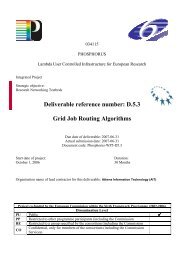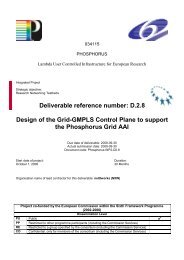D5.9: Extended Simulation Environment - Phosphorus
D5.9: Extended Simulation Environment - Phosphorus
D5.9: Extended Simulation Environment - Phosphorus
You also want an ePaper? Increase the reach of your titles
YUMPU automatically turns print PDFs into web optimized ePapers that Google loves.
D5.6 - <strong>Extended</strong> <strong>Simulation</strong> <strong>Environment</strong><br />
3.1.6 Residual Network<br />
The residual network for a new anycasting request is built with nodes with sufficient resources (e.g. memory,<br />
processor, etc.) and links with a residual capacity exceeding the request bandwidth requirement. Bandwidth<br />
requirements of both upstream and downstream routes are considered, and as such only reachable servers<br />
with enough resources are taken into account in the selection. Such servers are called available servers.<br />
3.1.7 Results<br />
The connection blocking probability is used as the comparison metric. The blocking probability is calculated for<br />
each class individually as the ratio of the number of blocked requests of that class to the total number of<br />
requests of that class. An anycast request is considered to be blocked if no available servers are found. Also<br />
Class 1 and Class 2 anycasting requests are blocked if either the upstream or downstream connections of the<br />
paths to the primary or the backup servers cannot be established. An anycast request of Class 3 is blocked if<br />
either the upstream or downstream connections of the path to the primary server cannot be established. The<br />
obtained results are averaged out over various cases of server locations. Results are collected in a specially<br />
defined structure and stored in an easily processed form.<br />
3.1.8 Traffic Generator<br />
The traffic of each node is simply generated prior to the start of the simulation and stored in a file. When a<br />
simulation is started, a function called read_anycasting_request() is used to fetch the traffic from the files into<br />
the nodes.<br />
For the simulation scenario, we assume the total traffic consists of 10% Class 1, 30% Class 2, and 60% Class<br />
3. As the anycast flow is asymmetrical, bandwidth requirements are assumed to be as follows: The upstream<br />
connections of all traffic classes are assumed to be 1 bandwidth unit. The downstream connections<br />
requirements are assumed to be uniformly distributed in the range of (4-10) units for Class 1 and Class 2.<br />
Requirements of Class 3 are assumed to be uniformly distributed in the range of (0-4) units. The values of<br />
these parameters can be easily changed to run the simulator under a different traffic scenario.<br />
3.1.9 Routing and Server Selection Algorithms<br />
The user can choose to run the simulator under any combination of the server selection algorithms (HNS, RCS<br />
and HNSW) and the routing algorithms (CSPF and LIOA) by executing the select_server() and<br />
routing_algorithm() functions.<br />
Project:<br />
<strong>Phosphorus</strong><br />
Deliverable Number: <br />
Date of Issue: 2009-03-31<br />
EC Contract No.: 034115<br />
Document Code: <br />
16






